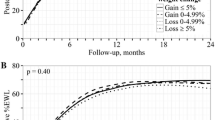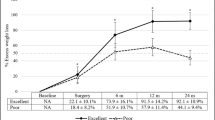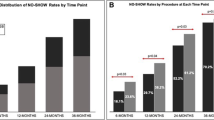Abstract
Background
Laparoscopic gastric bypass (LGB) has proven efficacy in causing significant and durable weight loss. However, the degree of postoperative weight loss and metabolic improvement varies greatly among individuals. Our study is aimed to identify independent predictors of successful weight loss after LGB.
Methods
Socioeconomic demographics were prospectively collected on patients undergoing LGB. Primary endpoint was percent of excess weight loss (EWL) at 1-year follow-up. Insufficient weight loss was defined as EWL ≤−1 SD from mean EWL. Logistic regression was used in both univariate and multivariate models to identify independent preoperative demographics associated with successful weight loss.
Results
A total of 180 consecutive patients were enrolled over 30 months. Mean preoperative body mass index (BMI) was 48. Mean EWL was 70.1 ± 17.3% (1 SD); therefore, success was defined as EWL ≥52.8%. According to this definition, 147 patients (81.7%) achieved successful weight loss 1 year after LGB. On univariate analysis, preoperative BMI had a significant effect on EWL, with patients with BMI <50 achieving a higher percentage of EWL (91.7% vs 61.6%; p = 0.001). Marriage status was also a significant predictor of successful outcome, with single patients achieving a higher percentage of EWL than married patients (89.8% vs 77.7%; p = 0.04).
Race had a noticeable but not statistically significant effect, with Caucasian patients achieving a higher percentage of EWL than African Americans (82.9% vs 60%; p = 0.06). Marital status remained an independent predictor of success in the multivariate logistic regression model after adjusting for covariates. Married patients were at more than two times the risk of failure compared to those who were unmarried (OR 2.6; 95% CI: 1.1–6.5, p = 0.04).
Conclusions
Weight loss achieved at 1 year after LGB is suboptimal in superobese patients. Single patients with BMI < 50 had the best chance of achieving greater weight loss.

Similar content being viewed by others
References
WHO (1946, July 22) Constitution of the World Health Organization. WHO, Geneva, Switzerland
Finkelstein EA, Fiebelkorn IC, Wang G (2004) State-level estimates of annual medical expenditures attributable to obesity. Obes Res 12: 18–24
Centers for Disease Control and Prevention, National Center for Health Statistics (2002) Prevalence of overweight and obesity among adults: United States, 1999–2000. Available online at http://www.cdc.gov/nchs/products/pubs/pubd/hestats/obese/obse99htm. Accessed October 24, 2002
Fisher BL, Schauer P (2002) Medical and surgical options in the treatment of severe obesity. Am J Surg 184: 9S–16S
Foster GD, Sarwer DB, Wadden TA (1997) Psychological effects of weight cycling in obese persons: a review and research agenda. Obes Res 5: 474–488
Wing R (1992) Weight cycling in humans: a review of the literature. Ann Behav Med 14: 113–119
Hall JC, Watts JM, O’Brien PE, Dunstan RE, Walsh JF, Slavotinek AH, Elmslie RG (1990) Gastric surgery for morbid obesity. The Adelaide Study. Ann Surg 211: 419–427
Brolin RL, Robertson LB, Kenler HA, Cody RP (1994) Weight loss and dietary intake after vertical banded gastroplasty and Roux-en-Y gastric bypass. Ann Surg 220: 782–790
Sugerman HJ, Kellum JM, Engle KM, Wolf L, Starkey JV, Birkenhauer R, Fletcher P, Sawyer MJ (1992) Gastric bypass for treating severe obesity. Am J Clin Nutr 55: 560S–566S
Ballantyne GH (2003) Measuring outcomes following bariatric surgery: weight loss parameters, improvement in co-morbid conditions, change in quality of life and patient satisfaction. Obes Surg 13: 954–964
Capella RF, Capella JF (1993) Ethnicity, type of obesity surgery and weight loss. Obes Surg 3: 375–380
Sugerman HJ, Londrey GL, Kellum JM, Wolf L, Liszka T, Engle KM, Birkenhauer R, Starkey JV (1989) Weight loss with vertical banded gastroplasty and Roux-Y gastric bypass for morbid obesity with selective versus random assignment. Am J Surg 157: 93–102
Choban PS, Flancbaum L (2002) The effect of Roux limb lengths on outcome after Roux-en-Y gastric bypass: a prospective, randomized clinical trial. Obes Surg 12: 540–545
Mason EE (1991) Why the operation I prefer is vertical banded gastroplasty 5.0. Obes Surg 1: 181–183
Sugerman HJ, Starkey JV, Birkenhauer R (1987) A randomized prospective trial of gastric bypass versus vertical banded gastroplasty for morbid obesity and their effects on sweets versus non-sweets eaters. Ann Surg 205: 613–624
Kothari SN, DeMaria EJ, Sugerman HJ, Kellum JM, Meador J, Wolfe L (2002) Lap-band failures: conversion to gastric bypass and their preliminary outcomes. Surgery 131: 625–629
Brolin RE (1992) Critical analysis of results: weight loss and quality of data. Am J Clin Nutr 55: 577S–581S
Brolin RE, Kenler HA, Gorman RC, Cody RP (1989) The dilemma of outcome assessment after operations for morbid obesity. Surgery 105: 337–346
Mason EE, Amaral J, Cowan GS Jr, Deitel M, Gleysteen JJ, Oria HE (1994) Standards for reporting results. Obes Surg 4: 56–65
Biron S, Hould FS, Lebel S, Marceau S, Lescelleur O, Simard S, Marceau P (2004) Twenty years of biliopancreatic diversion: what is the goal of the surgery? Obes Surg 14: 160–164
MacLean LD, Rhode BM, Shizgal HM (1981) Gastroplasty for obesity. Surg Gynecol Obstet 153: 200–208
Reinhold RB (1982) Critical analysis of long term weight loss following gastric bypass. Surg Gynecol Obstet 155: 385–394
Buchwald H, Avidor Y, Braunwald E, Jensen MD, Pories W, Fahrbach K, Schoelles K (2004) Bariatric surgery: a systematic review and meta-analysis. JAMA 292: 1724–1737
Weber M, Muller MK, Bucher T, Wildi S, Dindo D, Horber F, Hauser R, Clavien PA (2004) Laparoscopic gastric bypass is superior to laparoscopic gastric banding for treatment of morbid obesity. Ann Surg 240: 975–982; discussion 982–973
Dixon JB, Dixon ME, O’Brien PE (2001) Pre-operative predictors of weight loss at 1-year after Lap-Band surgery. Obes Surg 11: 200–207
Chau WY, Schmidt HJ, Kouli W, Davis D, Wasielewski A, Ballantyne GH (2005) Patient characteristics impacting excess weight loss following laparoscopic adjustable gastric banding. Obes Surg 15: 346–350
Brolin RE, Kenler HA, Gorman JH, Cody RP (1992) Long-limb gastric bypass in the superobese. A prospective randomized study. Ann Surg 215: 387–395
Dolan K, Hatzifotis M, Newbury L, Fielding G (2004) A comparison of laparoscopic adjustable gastric banding and biliopancreatic diversion in superobesity. Obes Surg 14: 165–169
Sanchez-Cabezudo Diaz-Guerra C, Larrad Jimenez A (2002) Analysis of weight loss with the biliopancreatic diversion of Larrad: absolute failures or relative successes? Obes Surg 12: 249–252
Acknowledgments
Rami Lutfi was supported by a Fellowship Grant from Ethicon Endosurgery. Alfonso Torquati is supported by the Vanderbilt Clinical Research Scholar Award.
Author information
Authors and Affiliations
Corresponding author
Rights and permissions
About this article
Cite this article
Lutfi, R., Torquati, A., Sekhar, N. et al. Predictors of success after laparoscopic gastric bypass: a multivariate analysis of socioeconomic factors. Surg Endosc 20, 864–867 (2006). https://doi.org/10.1007/s00464-005-0115-8
Received:
Accepted:
Published:
Issue Date:
DOI: https://doi.org/10.1007/s00464-005-0115-8




